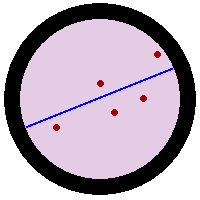This page is for a past course. Find your current course here.
Tutorial 1
Once you have access to an installation of Mathematica, you need to know how to use it.
Opening the Program
- On Windows computers in on-campus labs, go to Start Menu, then Programs, then Wolfram Mathematica. Click on the icon for Mathematica, named Spikey.
- Up will pop an introductory window. On the left hand side of this button is an option to create a new Mathematica notebook or open an old one. The notebook is where all your interactions with the program will take place.
First steps with Mathematica
- Download this file and save it to your computer: 245sp16tut1.nb
- Open the file. The file should look like a "Powerpoint" Presentation. If it does not, go to the Format Menu and click on "Format > Screen Environment > SlideShow".
- Follow this tutorial step-by-step and discuss the most interesting aspects with your neighbors.
- At the end of the tutorial, use the remaining class time to explore the power of Mathematica. (I'll be asking you about what you thought was the most interesting on an upcoming homework assignment.) I suggest looking in the Documentation Center (Help Menu) or at the Wolfram Demonstrations Project. Feel free to explore on your own or with your neighbors.
If you are having trouble getting started, here is what I do when I am exploring: - I go to the Documentation Center and type in a command (such as Manipulate)
- I do a quick look at the selected examples that are given and see if they are interesting.
- If so, I want to see all the examples. So I select the entire notebook (Ctrl-A or Apple-A) and then open all subgroups (Cell Menu: "Grouping > Open All Subgroups").
- I play around with the examples, moving sliders, changing variables to see what happens.
- If I see a command I do not know, I will search for it in the Documentation Center
- At the bottom of the file is a "See Also" section, which tells you similar commands.
- Also at the bottom are links to more in depth tutorials, which can be useful sometimes.
Other Items of Note!
Many of your initial errors will come about because of one of the following two problems:
- Mathematica is Case-SenSitive (AA is not the same as aA), so
be careful about what you type.
In particular, all built-in Mathematica functions are spelled out and capitalized, such as Table, ListPlot, IntegerPart, etc. - In Mathematica, it is important to distinguish between parentheses (), brackets [], and braces {}:
- Parentheses (): Used to group mathematical expressions, such as (3+4)/(5+7).
- Brackets []: Used when calling functions, such as N[Pi].
- Braces {}: Used when making lists, such as {i,1,20}.
- In Mathematica, there are four types of equals: =, :=, ==, and
===. You need to understand the difference between the first two.
- To define a variable to store it in memory, use =. For example, to define z to be 3, write z=3.
- You use == to check for equality. For example, 1-1==0 will evaluate to True and 1==0 will evaluate to False.
- You use := to define your own command. (This is advanced.)
- You will likely not use === in this class.
- One of the most important things to do is explore. If you are having trouble with a certain function, use the ? command to ask for help. Enter ? Table and the output will be a yellow box with a quick synopsis of the command. For more detailed information, click the blue >> at the bottom right of this yellow box. This will open the Documentation Center which gives examples of using the command in action, available options for this command, and anything else you might want to know about the command.
Algebra and Calculus
Mathematica will do everything your calculator can and more.- Use ^ to put something to a power.
- pi is Pi, e is E and sqrt(-1) is I.
- If you want to see the numerical approximation to a fraction or irrational number, use the function N. For example, to find the decimal represenation of pi, write N[Pi].
- Use E^x or Exp[x] to represent the function ex.
- To take the derivative of a function, use D and specify the derivative with respect to which variable. For instance D[x^2 + 3x, x].
- To take the integral of a function, use Integrate and specify the integral with respect to which variable. For instance Integrate[x^2 + 3x, x].
- To solve for the roots of ax2+bx+c=0 symbolically, use Solve[a x^2 + b x + c == 0, x].
Notice the double equals sign. (Mathematica is searching for when the expression is True.) - Coefficient[(1 + x)^10, x^3] gives the coefficient of x3 in the expansion of (1 + x)10.
